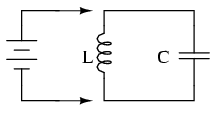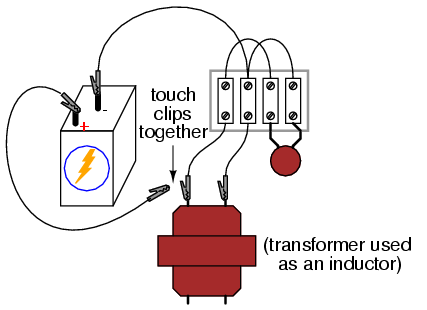Inductor-capacitor "tank" circuit
PARTS AND MATERIALS
The power transformer is used simply as an
inductor, with only one winding connected. The unused
winding should be left open. A simple iron core,
single-winding inductor (sometimes known as a choke)
may also be used, but such inductors are more difficult to
obtain than power transformers.
CROSS-REFERENCES
Lessons In Electric Circuits, Volume
2, chapter 6: "Resonance"
LEARNING OBJECTIVES
-
How to build a resonant circuit
-
Effects of capacitor size on resonant
frequency
-
How to produce antiresonance
SCHEMATIC DIAGRAM

ILLUSTRATION

INSTRUCTIONS
If an inductor and a capacitor are connected
in parallel with each other, and then briefly energized by
connection to a DC voltage source, oscillations will ensue
as energy is exchanged from the capacitor to inductor and
visa-versa. These oscillations may be viewed with an
oscilloscope connected in parallel with the
inductor/capacitor circuit. Parallel inductor/capacitor
circuits are commonly known as tank circuits.
Important note: I recommend
against using a PC/sound card as an oscilloscope for
this experiment, because very high voltages can be generated
by the inductor when the battery is disconnected (inductive
"kickback"). These high voltages will surely damage the
sound card's input, and perhaps other portions of the
computer as well.
A tank circuit's natural frequency, called
the resonant frequency, is determined by the size of
the inductor and the size of the capacitor, according to the
following equation:

Many small power transformers have primary
(120 volt) winding inductances of approximately 1 H. Use
this figure as a rough estimate of inductance for your
circuit to calculate expected oscillation frequency.
Ideally, the oscillations produced by a tank
circuit continue indefinitely. Realistically, oscillations
will decay in amplitude over the course of several cycles
due to the resistive and magnetic losses of the inductor.
Inductors with a high "Q" rating will, of course, produce
longer-lasting oscillations than low-Q inductors.
Try changing capacitor values and noting the
effect on oscillation frequency. You might notice changes in
the duration of oscillations as well, due to capacitor size.
Since you know how to calculate resonant frequency from
inductance and capacitance, can you figure out a way to
calculate inductor inductance from known values of circuit
capacitance (as measured by a capacitance meter) and
resonant frequency (as measured by an oscilloscope)?
Resistance may be intentionally added to the
circuit -- either in series or parallel -- for the express
purpose of dampening oscillations. This effect of resistance
dampening tank circuit oscillation is known as
antiresonance. It is analogous to the action of a shock
absorber in dampening the bouncing of a car after striking a
bump in the road.
COMPUTER SIMULATION
Schematic with SPICE node numbers:

Rstray is placed in the circuit
to dampen oscillations and produce a more realistic
simulation. A lower Rstray value causes
longer-lived oscillations because less energy is dissipated.
Eliminating this resistor from the circuit results in
endless oscillation.
Netlist (make a text file containing the
following text, verbatim):
tank circuit with loss
l1 1 0 1 ic=0
rstray 1 2 1000
c1 2 0 0.1u ic=6
.tran 0.1m 20m uic
.plot tran v(1,0)
.end
|